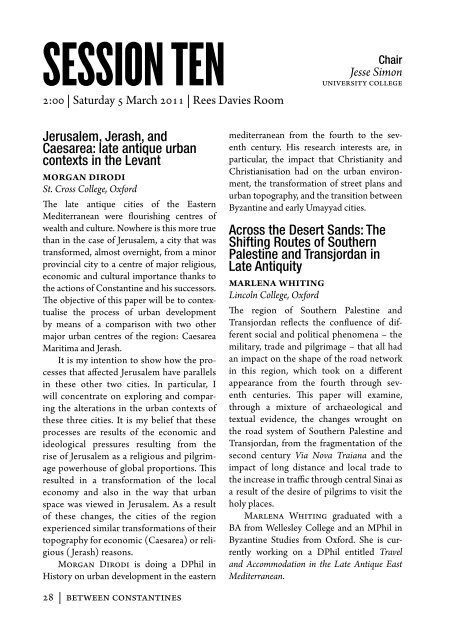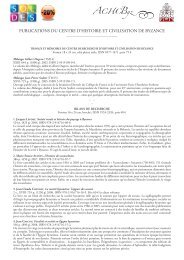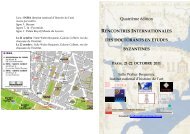booklet of abstracts - Oxford University Byzantine Society
booklet of abstracts - Oxford University Byzantine Society
booklet of abstracts - Oxford University Byzantine Society
Create successful ePaper yourself
Turn your PDF publications into a flip-book with our unique Google optimized e-Paper software.
Session ten2:00 | Saturday 5 March 2011 | Rees Davies RoomChairJesse Simon<strong>University</strong> CollegeJerusalem, Jerash, andCaesarea: late antique urbancontexts in the LevantMorgan DirodiSt. Cross College, <strong>Oxford</strong>The late antique cities <strong>of</strong> the EasternMediterranean were flourishing centres <strong>of</strong>wealth and culture. Nowhere is this more truethan in the case <strong>of</strong> Jerusalem, a city that wastransformed, almost overnight, from a minorprovincial city to a centre <strong>of</strong> major religious,economic and cultural importance thanks tothe actions <strong>of</strong> Constantine and his successors.The objective <strong>of</strong> this paper will be to contextualisethe process <strong>of</strong> urban developmentby means <strong>of</strong> a comparison with two othermajor urban centres <strong>of</strong> the region: CaesareaMaritima and Jerash.It is my intention to show how the processesthat affected Jerusalem have parallelsin these other two cities. In particular, Iwill concentrate on exploring and comparingthe alterations in the urban contexts <strong>of</strong>these three cities. It is my belief that theseprocesses are results <strong>of</strong> the economic andideological pressures resulting from therise <strong>of</strong> Jerusalem as a religious and pilgrimagepowerhouse <strong>of</strong> global proportions. Thisresulted in a transformation <strong>of</strong> the localeconomy and also in the way that urbanspace was viewed in Jerusalem. As a result<strong>of</strong> these changes, the cities <strong>of</strong> the regionexperienced similar transformations <strong>of</strong> theirtopography for economic (Caesarea) or religious( Jerash) reasons.Morgan Dirodi is doing a DPhil inHistory on urban development in the easternmediterranean from the fourth to the seventhcentury. His research interests are, inparticular, the impact that Christianity andChristianisation had on the urban environment,the transformation <strong>of</strong> street plans andurban topography, and the transition between<strong>Byzantine</strong> and early Umayyad cities.Across the Desert Sands: TheShifting Routes <strong>of</strong> SouthernPalestine and Transjordan inLate AntiquityMarlena WhitingLincoln College, <strong>Oxford</strong>The region <strong>of</strong> Southern Palestine andTransjordan reflects the confluence <strong>of</strong> differentsocial and political phenomena – themilitary, trade and pilgrimage – that all hadan impact on the shape <strong>of</strong> the road networkin this region, which took on a differentappearance from the fourth through seventhcenturies. This paper will examine,through a mixture <strong>of</strong> archaeological andtextual evidence, the changes wrought onthe road system <strong>of</strong> Southern Palestine andTransjordan, from the fragmentation <strong>of</strong> thesecond century Via Nova Traiana and theimpact <strong>of</strong> long distance and local trade tothe increase in traffic through central Sinai asa result <strong>of</strong> the desire <strong>of</strong> pilgrims to visit theholy places.Marlena Whiting graduated with aBA from Wellesley College and an MPhil in<strong>Byzantine</strong> Studies from <strong>Oxford</strong>. She is currentlyworking on a DPhil entitled Traveland Accommodation in the Late Antique EastMediterranean.28 | Between Constantines





